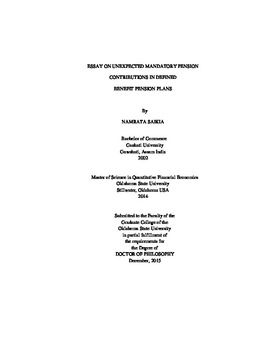| dc.contributor.advisor | Rao, Ramesh P. | |
| dc.contributor.author | Saikia, Namrata | |
| dc.date.accessioned | 2017-02-22T22:11:42Z | |
| dc.date.available | 2017-02-22T22:11:42Z | |
| dc.date.issued | 2015-12 | |
| dc.identifier.uri | https://hdl.handle.net/11244/48924 | |
| dc.description.abstract | Corporate sponsors of defined benefit (DB) pension plans in the US are legally required (if underfunded) to make mandatory pension contribution (MPC) as a non-linear function of the funding status of the pension plan. Prior literature finds that sponsor firms react to unexpected MPC by reducing capital expenditures. This study builds upon this framework to determine if a symmetric pattern exists in the response of capital expenditures to whether unexpected MPC is unfavorable (additional cash contributions) or favorable (less cash contributions). We find additional cash contributions or expense have a significant negative impact on investments of cash-constrained sponsor firms (whose capital expenditure exceeds their cash flow frequently). However, reduced cash contributions or saving do not exhibit a significant relationship with investments, thus, indicating an asymmetric relationship of capital investments with saving and expense. | |
| dc.description.abstract | Previous findings observe an increased prevalence of risk shifting tendencies among sponsors with well-funded plans and better credit ratings. Consistent with this style of risk-shifting, this study finds a higher probability of unexpected MPC (both saving and expense) for high-rated sponsors that opt for greater risk (equity) in their pension asset allocation. Results also indicate that plans opting for increased equity allocation face a significantly greater incidence of additional contributions - an explanation to why weakly-funded plans or low-rated firms are less inclined toward risky allocations in their pension investment strategies. | |
| dc.description.abstract | Additionally, I document a positive relationship of unexpected MPC (and expense) with cash flow volatility of the firm and expect this to translate into a higher cost of debt for the firm. However, my findings do not support a positive relationship between unexpected MPC (and expense) and borrowing costs. There is evidence that unexpected savings lead to a lower cost of debt in case of non-investment grade bonds for the Pension & Investments data sample but this result could be sensitive to the sample size and needs further validation. | |
| dc.format | application/pdf | |
| dc.language | en_US | |
| dc.rights | Copyright is held by the author who has granted the Oklahoma State University Library the non-exclusive right to share this material in its institutional repository. Contact Digital Library Services at lib-dls@okstate.edu or 405-744-9161 for the permission policy on the use, reproduction or distribution of this material. | |
| dc.title | Essay on unexpected mandatory pension contributions in defined benefit pension plans | |
| dc.contributor.committeeMember | Harper, Joel T. | |
| dc.contributor.committeeMember | Trennepohl, Gary L. | |
| dc.contributor.committeeMember | Schwartz, William C., Jr. | |
| osu.filename | Saikia_okstate_0664D_14419.pdf | |
| osu.accesstype | Open Access | |
| dc.type.genre | Dissertation | |
| dc.type.material | Text | |
| thesis.degree.discipline | Business Administration | |
| thesis.degree.grantor | Oklahoma State University | |
